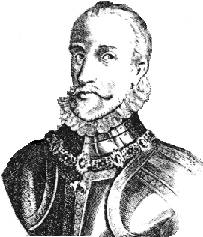
Lamoral, Count of Egmont (November 18, 1522, La Hamaide near Ellezelles – June 5, 1568, Brussels) was a general and statesman in Flanders just before the start of the Eighty Years' War.
The Count of Egmont descended from one of the richest and most influential families in the Low Countries. He was a cousin of the king of Spain through his mother's side. During his youth, he received a military education in Spain. In 1542, he inherited the estates of his brother Charles in Holland. His wealth increased again by his marriage to Sabina, Duchess of Bavaria in 1544.
In the service of the Spanish army, he defeated the French in the battles of Saint-Quentin (1557) and Gravelines (1558). Egmont was appointed stadtholder of Flanders and Artois in 1559.
As a nobleman, Egmont was a member of the Council of State. Together with William of Orange and the Count of Hoorn he protested against the introduction of the inquisition in Flanders by cardinal Antoine Perrenot Granvelle, bishop of Arras. Egmont even threatened with his resignation, but after Granvelle left, there was a reconciliation with the king. In 1565, Egmont went to Philip II, the king of Spain, to plead for a change of policy in the Netherlands.
Shortly after, the Iconoclasm started, and the resistance against the Spanish rule in the Netherlands increased. As a devout Catholic, Egmont deplored the iconoclasm, and he remained faithful to the Spanish king.
After Philip II sent the Duke of Alba to the Netherlands, William of Orange decided to flee Brussels; Egmont and Hoorne decided to stay in the city. After his arrival, Alba almost immediately had the counts of Egmont and Hoorne arrested, and they were accused of treason. Even though Egmont remained faithful to the king until the last moment, he was condemned to death, together with Count Hoorne.
On June 5, 1568, both men were decapitated on the Grand-Place in Brussels. Their death led to large protests in the Netherlands, and contributed to the resistance against the Spaniards. The Count of Egmont lies buried in Zottegem.
The Count of Egmont is the main character in a play by Goethe, Egmont In 1810 Ludwig van Beethoven composed an overture and incidental music for a revival of the play.